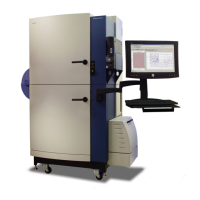FLIPR
®
Tetra High Throughput Cellular Screening System User Guide
0112-0109 H 189
Cell Densities
A variety of cell handling conditions may be adopted at your discretion
based on standard operating procedures in the laboratory.
Non-adherent cells are typically plated on the day of experiment on a
coated plate (for example, poly-d-lysine or collagen) to assist cell
adherence to the plate bottom. We recommend you then centrifuge the
plates at 100g for up to 4 min with the brake off. Adherent cells are
seeded the day prior to an experiment and incubated in a 5% CO
2
, 37
°C incubator overnight. To create an 80–90% confluent cell monolayer,
it is recommended the cells be seeded at densities shown in the table
below. For suspension experiments, cells are loaded into a cell flask on
the day of the experiment and are pipetted via the instrument into the
read plate, so the flask concentration as well as the volume pipetted
controls the final concentration.
The recommended concentrations are listed in the following table.
Coelenterazine Loading For Adherent Assays
To load the cells for an adherent assay:
1. Before the day of the assay, remove culture medium from wells.
2. Wash cells in ‘BSA Medium’ containing DMEM/HAM’s F12 with
HEPES, without phenol red, catalog# 11039-021 (Invitrogen) +
0.1% BSA.
3. In reduced lighting conditions, make up a solution of
coelenterazine appropriate for your cell type, in ‘BSA Medium’
and add a volume of 100 μL (96-well plates), 25 μL (384-well
Incubator MLS
Centrifuge MLS
Pipettor and sterile tips suitable for
use with microplates
MLS
Cell Type
(cells/well)
96-Well Plate
(100 μL
growth
medium)
384-Well Plate
(25 μL growth
medium)
1536-Well
Plate
(2–3 μL
growth
medium)
Adherent cells 5,000–50,000 1,250–15,000 1,000–2,500
Non-adherent
cells
40,000–100,000 10,000–60,000 2500–-15,000
Suspension cells 10,000–40,000 2,500–10,000 1,000–5,000
Item Source

